Resonance Raman Spectroscopy of Mn-Mgk Cation Complexes in GaN
Abstract
1. Introduction
2. Materials and Methods
3. Results and Discussion
3.1. Raman Spectroscopy at Sub-Band Excitation
3.2. Raman Spectroscopy at Inter-Band Excitation
4. Conclusions
Author Contributions
Funding
Acknowledgments
Conflicts of Interest
References
- Passow, T.; Gutt, R.; Kunzer, M.; Pletschen, W.; Kirste, L.; Forghani, K.; Scholz, F.; Köhler, K.; Wagner, J. High Power Efficiency AlGaN-Based Ultraviolet Light-Emitting Diodes. Jpn. J. Appl. Phys. 2013, 52, 08JG16. [Google Scholar] [CrossRef]
- Yoshida, H.; Yamashita, Y.; Kuwabara, M.; Kan, H. A 342-nm ultraviolet AlGaN multiple-quantum-well laser diode. Nat. Photonics 2008, 2, 551–554. [Google Scholar] [CrossRef]
- Amano, H.; Baines, Y.; Beam, E.; Borga, M.; Bouchet, T.; Chalker, P.R.; Charles, M.; Chen, K.J.; Chowdhury, N.; Chu, R.; et al. The 2018 GaN power electronics roadmap. J. Phys. D. Appl. Phys. 2018, 51, 163001. [Google Scholar] [CrossRef]
- Devillers, T.; Rovezzi, M.; Szwacki, N.G.; Dobkowska, S.; Stefanowicz, W.; Sztenkiel, D.; Grois, A.; Suffczyński, J.; Navarro-Quezada, A.; Faina, B.; et al. Manipulating Mn–Mgk cation complexes to control the charge- and spin-state of Mn in GaN. Sci. Rep. 2012, 2, 722. [Google Scholar] [CrossRef] [PubMed]
- Capuzzo, G.; Kysylychyn, D.; Adhikari, R.; Li, T.; Faina, B.; Tarazaga Martín-Luengo, A.; Bonanni, A. All-nitride AlxGa1−xN:Mn/GaN distributed Bragg reflectors for the near-infrared. Sci. Rep. 2017, 7, 42697. [Google Scholar] [CrossRef] [PubMed]
- Wagner, J. Raman spectroscopy for impurity characterization in III-V semiconductors. Appl. Surf. Sci. 1991, 50, 79–86. [Google Scholar] [CrossRef]
- Semiconductor Research; Patane, A., Balkan, N., Eds.; Springer Series in Materials Science; Springer: Berlin/Heidelberg, Germany, 2012; Volume 150, ISBN 978-3-642-23350-0. [Google Scholar] [CrossRef]
- Devillers, T.; Leite, D.M.G.; Dias da Silva, J.H.; Bonanni, A. Functional Mn–Mgk cation complexes in GaN featured by Raman spectroscopy. Appl. Phys. Lett. 2013, 103, 211909. [Google Scholar] [CrossRef]
- Gebicki, W.; Dominik, P.; Podsiadlo, S. Lattice dynamics and Raman scattering from GaN:Mn crystals. Phys. Rev. B 2008, 77, 245213. [Google Scholar] [CrossRef]
- Kaschner, A.; Siegle, H.; Kaczmarczyk, G.; Strassburg, M.; Hoffmann, A.; Thomsen, C.; Birkle, U.; Einfeldt, S.; Hommel, D. Local vibrational modes in Mg-doped GaN grown by molecular beam epitaxy. Appl. Phys. Lett. 1999, 74, 3281–3283. [Google Scholar] [CrossRef]
- Harima, H.; Inoue, T.; Nakashima, S.; Ishida, M.; Taneya, M. Local vibrational modes as a probe of activation process in p-type GaN. Appl. Phys. Lett. 1999, 75, 1383–1385. [Google Scholar] [CrossRef]
- Limmer, W.; Ritter, W.; Sauer, R.; Mensching, B.; Liu, C.; Rauschenbach, B. Raman scattering in ion-implanted GaN. Appl. Phys. Lett. 1998, 72, 2589–2591. [Google Scholar] [CrossRef]
- Hasuike, N.; Fukumura, H.; Harima, H.; Kisoda, K.; Hashimoto, M.; Zhou, Y.K.; Asahi, H. Optical studies on GaN-based spintronics materials. J. Physics-Condensed Matter 2004, 16, S5811–S5814. [Google Scholar] [CrossRef]
- Bonanni, A.; Sawicki, M.; Devillers, T.; Stefanowicz, W.; Faina, B.; Li, T.; Winkler, T.E.; Sztenkiel, D.; Navarro-Quezada, A.; Rovezzi, M.; et al. Experimental probing of exchange interactions between localized spins in the dilute magnetic insulator (Ga,Mn)N. Phys. Rev. B Condens. Matter Mater. Phys. 2011, 84, 1–11. [Google Scholar] [CrossRef]
- Flack, T.J.; Pushpakaran, B.N.; Bayne, S.B. GaN Technology for Power Electronic Applications: A Review. J. Electron. Mater. 2016, 45, 2673–2682. [Google Scholar] [CrossRef]
- Morkoc, H. Handbook of Nitride Semiconductors and Devices; Wiley-VCH Verlag GmbH & Co. KGaA: Weinheim, Germany, 2008; ISBN 9783527628438. [Google Scholar]
- Lee, H.-P.; Perozek, J.; Rosario, L.D.; Bayram, C. Investigation of AlGaN/GaN high electron mobility transistor structures on 200-mm silicon (111) substrates employing different buffer layer configurations. Sci. Rep. 2016, 6, 37588. [Google Scholar] [CrossRef] [PubMed]
- Ilchenko, O.; Pilgun, Y.; Makhnii, T.; Slipets, R.; Reynt, A.; Kutsyk, A.; Slobodianiuk, D.; Koliada, A.; Krasnenkov, D.; Kukharskyy, V. High-speed line-focus Raman microscopy with spectral decomposition of mouse skin. Vib. Spectrosc. 2016, 83, 180–190. [Google Scholar] [CrossRef]
- Dias da Silva, J.H.; Leite, D.M.G.; Zanatta, A.R. Resonant excitation of Mn local vibrational modes in the higher order Raman spectra of nanocrystalline Ga1−xMnxN films. J. Phys. Condens. Matter 2008, 20, 252201. [Google Scholar] [CrossRef]
- Demangeot, F.; Frandon, J.; Renucci, M.A.; Briot, O.; Gil, B.; Aulombard, R.L. Raman determination of phonon deformation potentials in α-GaN. Solid State Commun. 1996, 100, 207–210. [Google Scholar] [CrossRef]
- Graf, T.; Gjukic, M.; Brandt, M.S.; Stutzmann, M.; Ambacher, O. The Mn3+/2+ acceptor level in group III nitrides. Appl. Phys. Lett. 2002, 81, 5159–5161. [Google Scholar] [CrossRef]
- Kysylychyn, D.; Suffczyński, J.; Woźniak, T.; Gonzalez Szwacki, N.; Bonanni, A. Resonant excitation of infrared emission in GaN:(Mn,Mg). Phys. Rev. B 2018, 97, 245311. [Google Scholar] [CrossRef]
- Han, B.; Wessels, B.W.; Ulmer, M.P. Optical investigation of electronic states of Mn4+ ions in p-type GaN. Appl. Phys. Lett. 2005, 86, 1–4. [Google Scholar] [CrossRef][Green Version]
- Zenneck, J.; Niermann, T.; Mai, D.; Roever, M.; Kocan, M.; Malindretos, J.; Seibt, M.; Rizzi, A.; Kaluza, N.; Hardtdegen, H. Intra-atomic photoluminescence at 1.41 eV of substitutional Mn in GaMnN of high optical quality. J. Appl. Phys. 2007, 101, 2005–2008. [Google Scholar] [CrossRef]
- Zhang, Q.; Zhang, J.; Utama, M.I.B.; Peng, B.; De La Mata, M.; Arbiol, J.; Xiong, Q. Exciton-phonon coupling in individual ZnTe nanorods studied by resonant Raman spectroscopy. Phys. Rev. B Condens. Matter Mater. Phys. 2012, 85, 1–9. [Google Scholar] [CrossRef]
- Suffczyński, J.; Grois, A.; Pacuski, W.; Golnik, A.; Gaj, J.A.; Navarro-Quezada, A.; Faina, B.; Devillers, T.; Bonanni, A. Effects of s,p-d and s-p exchange interactions probed by exciton magnetospectroscopy in (Ga,Mn)N. Phys. Rev. B Condens. Matter Mater. Phys. 2011, 83, 1–8. [Google Scholar] [CrossRef]
- Martin, R.M.; Varma, C.M. Cascade Theory of Inelastic Scattering of Light. Phys. Rev. Lett. 1971, 26, 1241–1244. [Google Scholar] [CrossRef]
- Sun, W.H.; Chua, S.J.; Wang, L.S.; Zhang, X.H. Outgoing multiphonon resonant Raman scattering and luminescence in Be- and C-implanted GaN. J. Appl. Phys. 2002, 91, 4917–4921. [Google Scholar] [CrossRef]
- Kaschner, A.; Hoffmann, A.; Thomsen, C. Resonant Raman scattering on free and bound excitons in GaN. Phys. Rev. B Condens. Matter Mater. Phys. 2001, 64, 1–7. [Google Scholar] [CrossRef]
- Muth, J.F.; Lee, J.H.; Shmagin, I.K.; Kolbas, R.M.; Casey, H.C.; Keller, B.P.; Mishra, U.K.; DenBaars, S.P. Absorption coefficient, energy gap, exciton binding energy, and recombination lifetime of GaN obtained from transmission measurements. Appl. Phys. Lett. 1997, 71, 2572–2574. [Google Scholar] [CrossRef]
- Guo, L.L.; Shen, W.Z.; Zhang, Y.H. Temperature dependence of the optical properties in GaMnN. J. Appl. Phys. 2006, 99, 113533. [Google Scholar] [CrossRef]
- Shan, W.; Schmidt, T.J.; Yang, X.H.; Hwang, S.J.; Song, J.J.; Goldenberg, B. Temperature dependence of interband transitions in GaN grown by metalorganic chemical vapor deposition. Appl. Phys. Lett. 1995, 66, 985–987. [Google Scholar] [CrossRef]
- Ursaki, V.V.; Tiginyanu, I.M.; Zalamai, V.V.; Rusu, E.V.; Emelchenko, G.A.; Masalov, V.M.; Samarov, E.N. Multiphonon resonant Raman scattering in ZnO crystals and nanostructured layers. Phys. Rev. B Condens. Matter Mater. Phys. 2004, 70, 1–8. [Google Scholar] [CrossRef]
- Morgan, T.N. Broadening of Impurity Bands in Heavily Doped Semiconductors. Phys. Rev. 1965, 139, A343–A348. [Google Scholar] [CrossRef]
- Iliopoulos, E.; Doppalapudi, D.; Ng, H.M.; Moustakas, T.D. Broadening of near-band-gap photoluminescence in n-GaN films. Appl. Phys. Lett. 1998, 73, 375–377. [Google Scholar] [CrossRef]
- García-Cristbal, A.; Cantarero, A.; Trallero-Giner, C.; Cardona, M. Excitonic model for second-order resonant Raman scattering. Phys. Rev. B 1994, 49, 13430–13445. [Google Scholar] [CrossRef]
- Martin, R.M. Resonance raman scattering near critical points. Phys. Rev. B 1974, 10, 2620–2631. [Google Scholar] [CrossRef]
- Jhalani, V.A.; Zhou, J.-J.; Bernardi, M. Ultrafast Hot Carrier Dynamics in GaN and Its Impact on the Efficiency Droop. Nano Lett. 2017, 17, 5012–5019. [Google Scholar] [CrossRef] [PubMed]
- Zhukov, V.P.; Tyuterev, V.G.; Chulkov, E.V.; Echenique, P.M. Electron-phonon relaxation and excited electron distribution in gallium nitride. J. Appl. Phys. 2016, 120, 085708. [Google Scholar] [CrossRef]
- Wang, K.; Simon, J.; Goel, N.; Jena, D. Optical study of hot electron transport in GaN: Signatures of the hot-phonon effect. Appl. Phys. Lett. 2006, 88, 1–3. [Google Scholar] [CrossRef]
- Smoleński, T.; Kazimierczuk, T.; Kobak, J.; Goryca, M.; Golnik, A.; Kossacki, P.; Pacuski, W. Magnetic ground state of an individual Fe2+ ion in strained semiconductor nanostructure. Nat. Commun. 2016, 7, 1–7. [Google Scholar] [CrossRef] [PubMed]
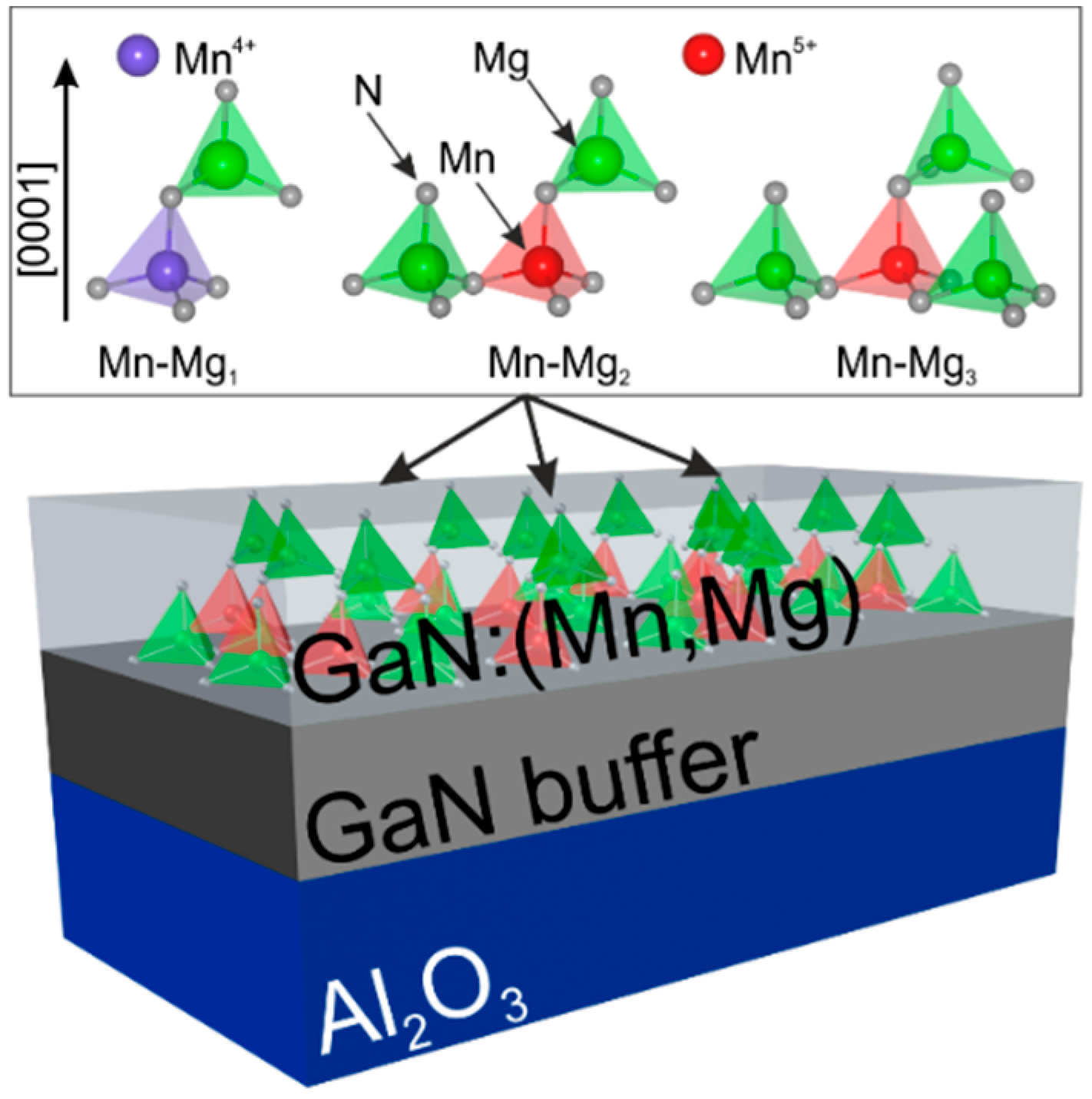
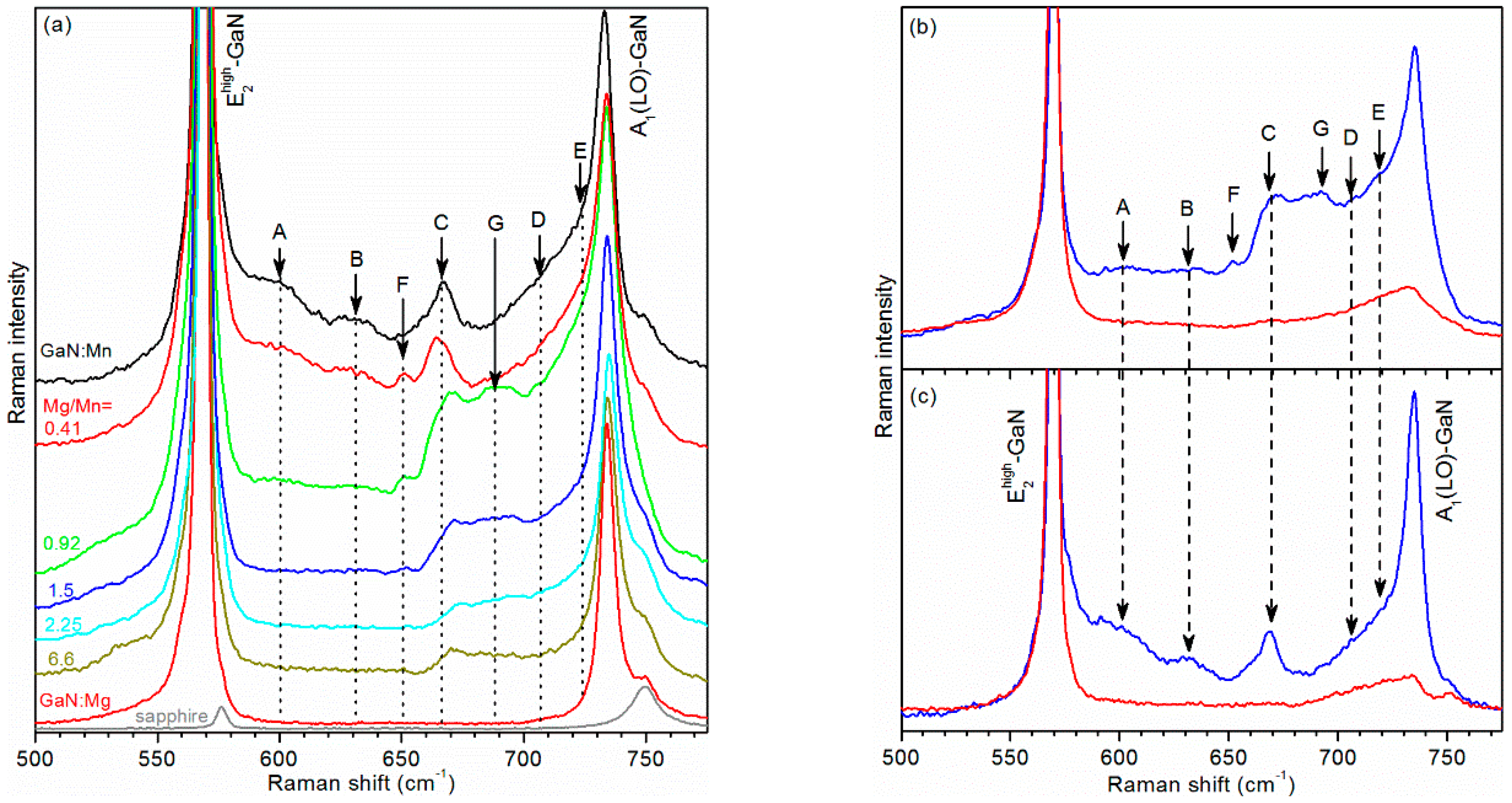
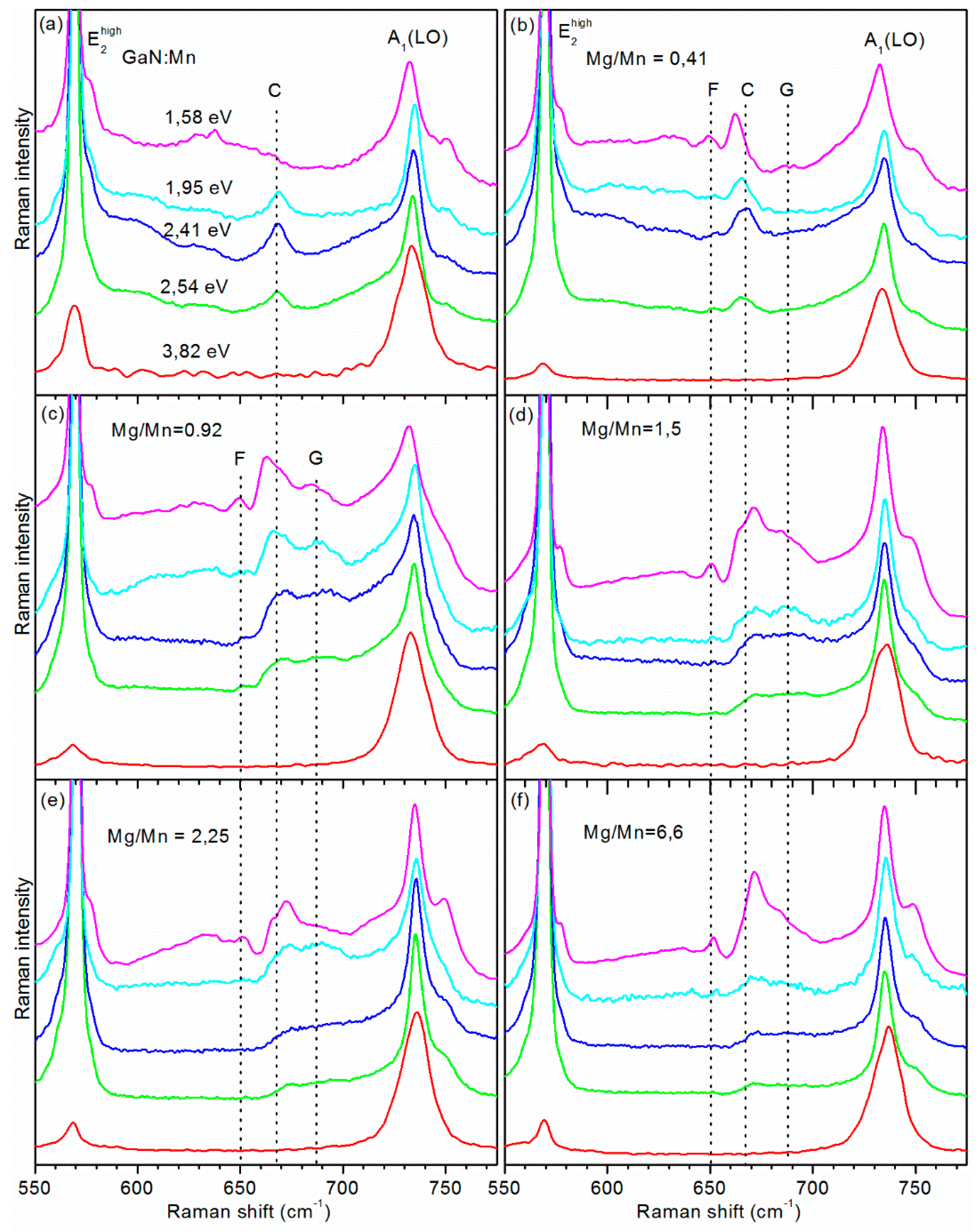

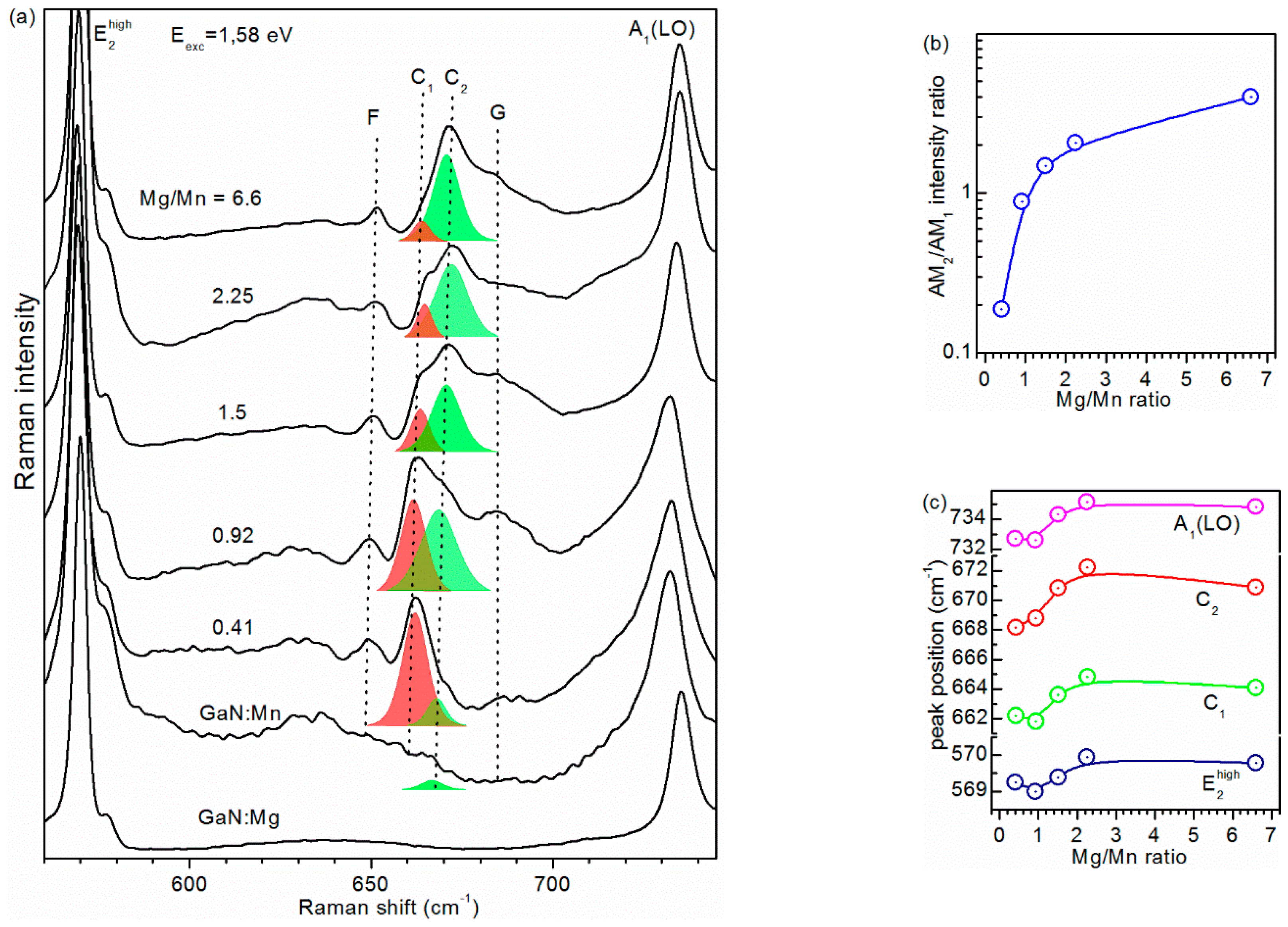
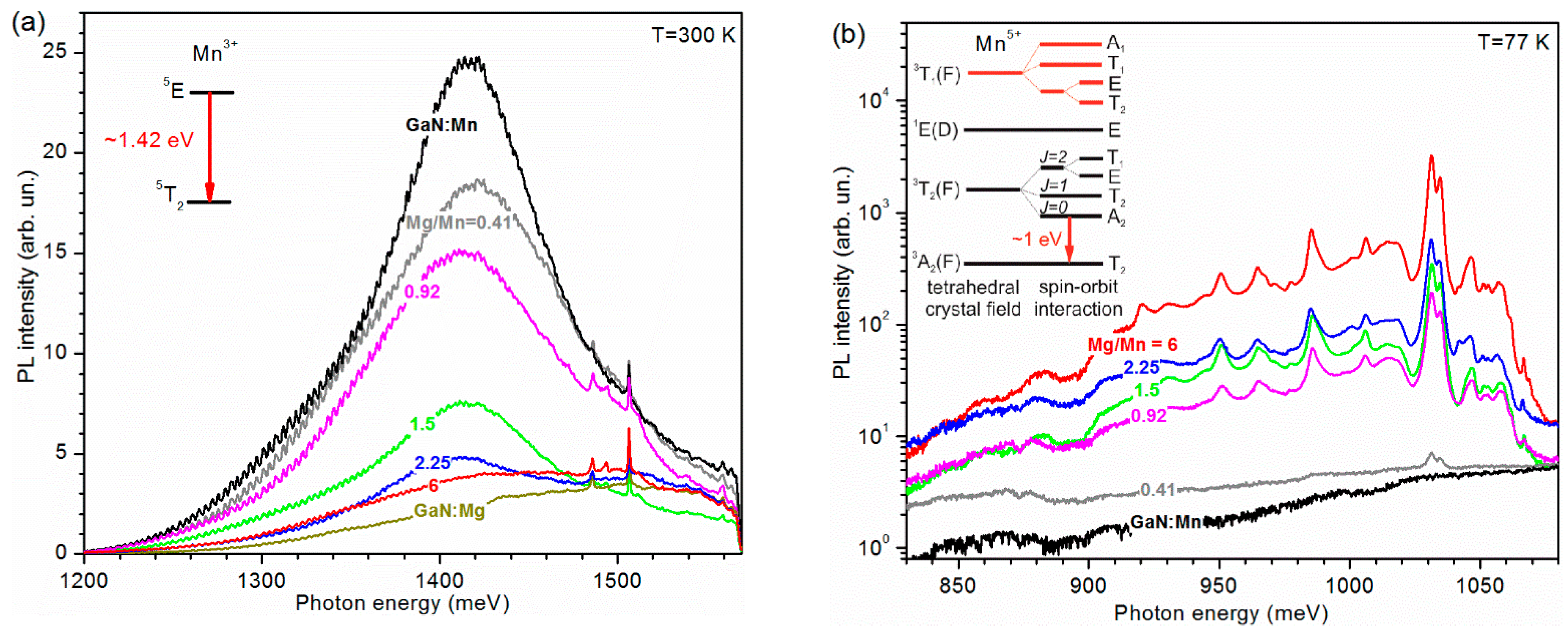
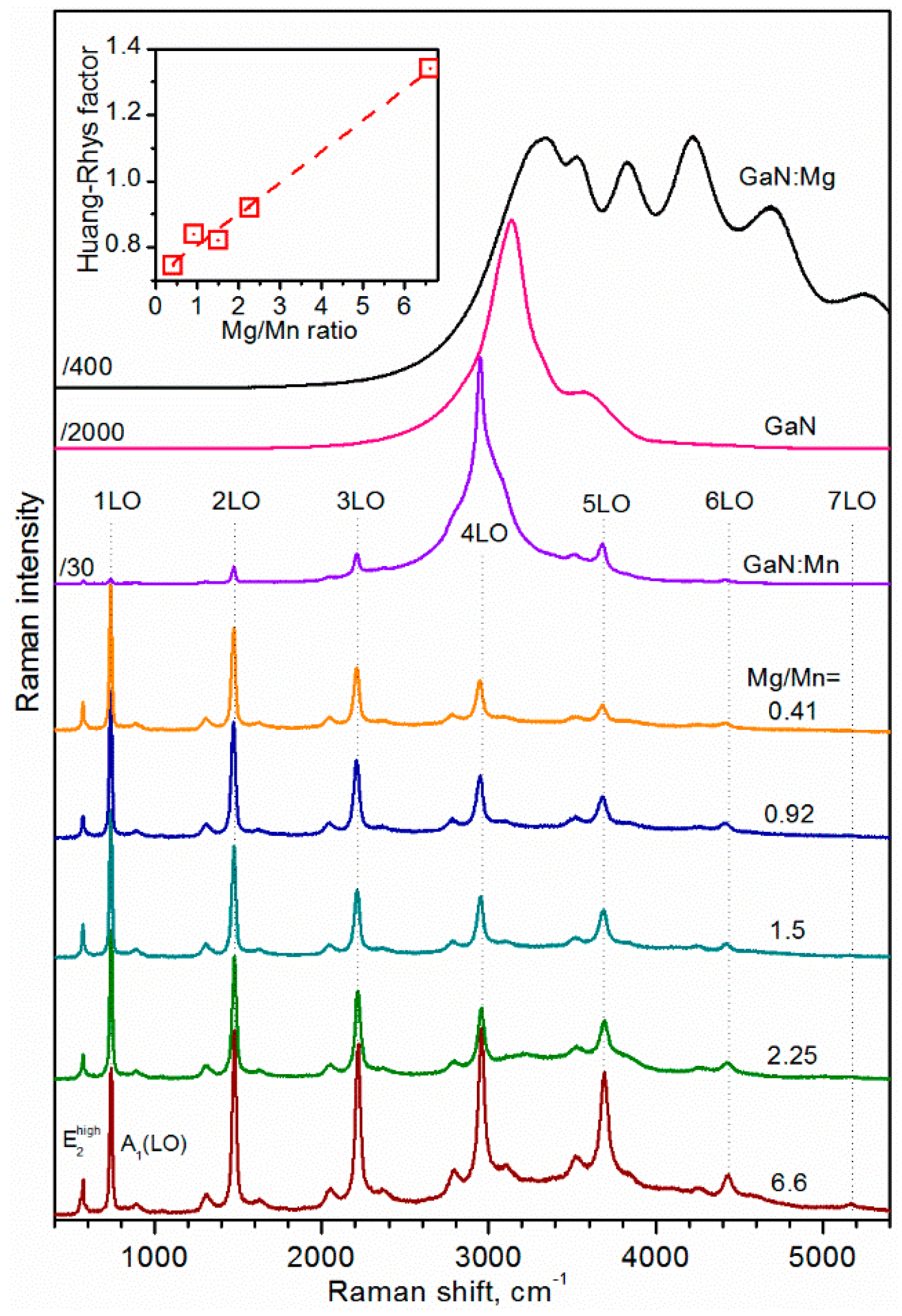
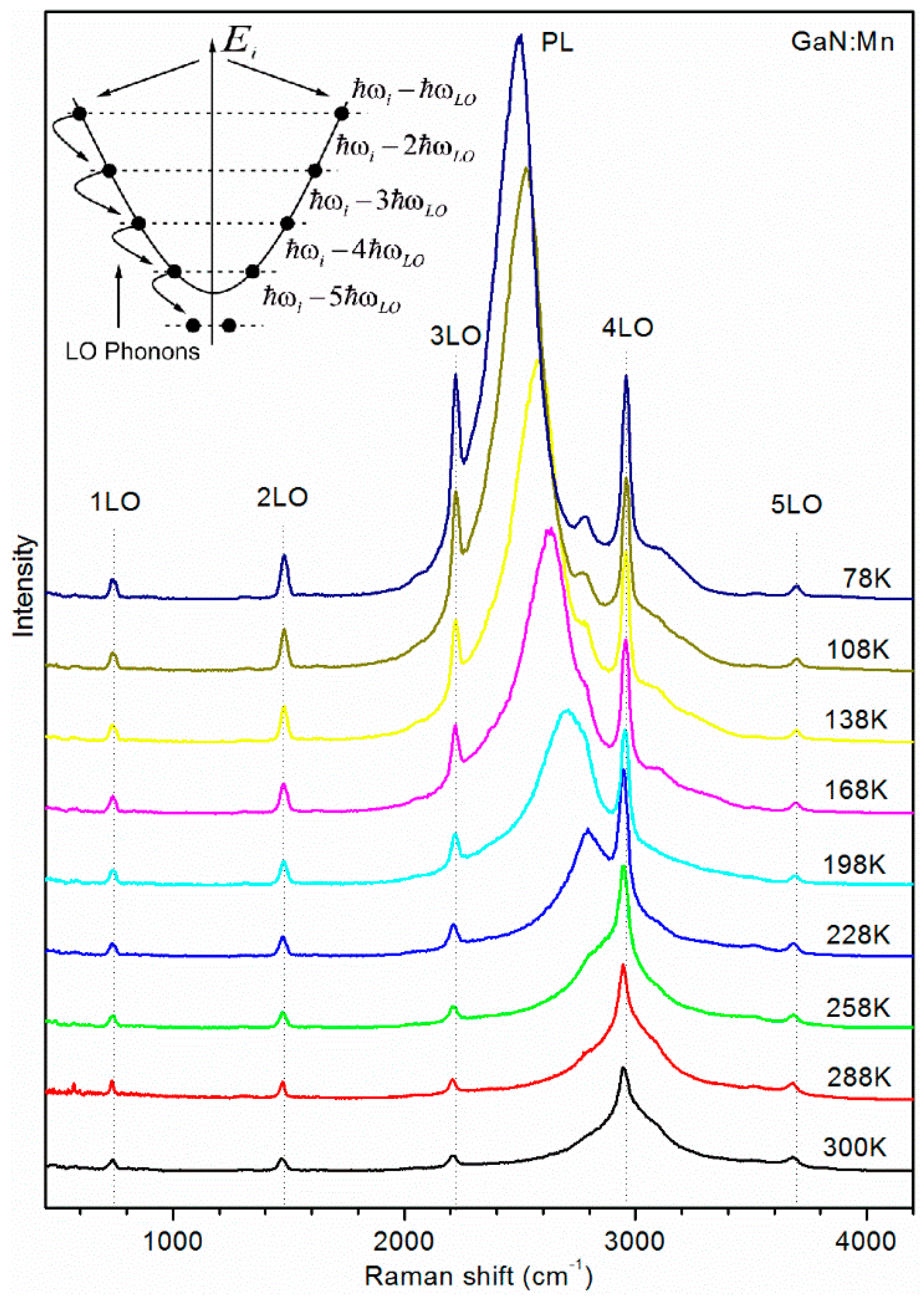
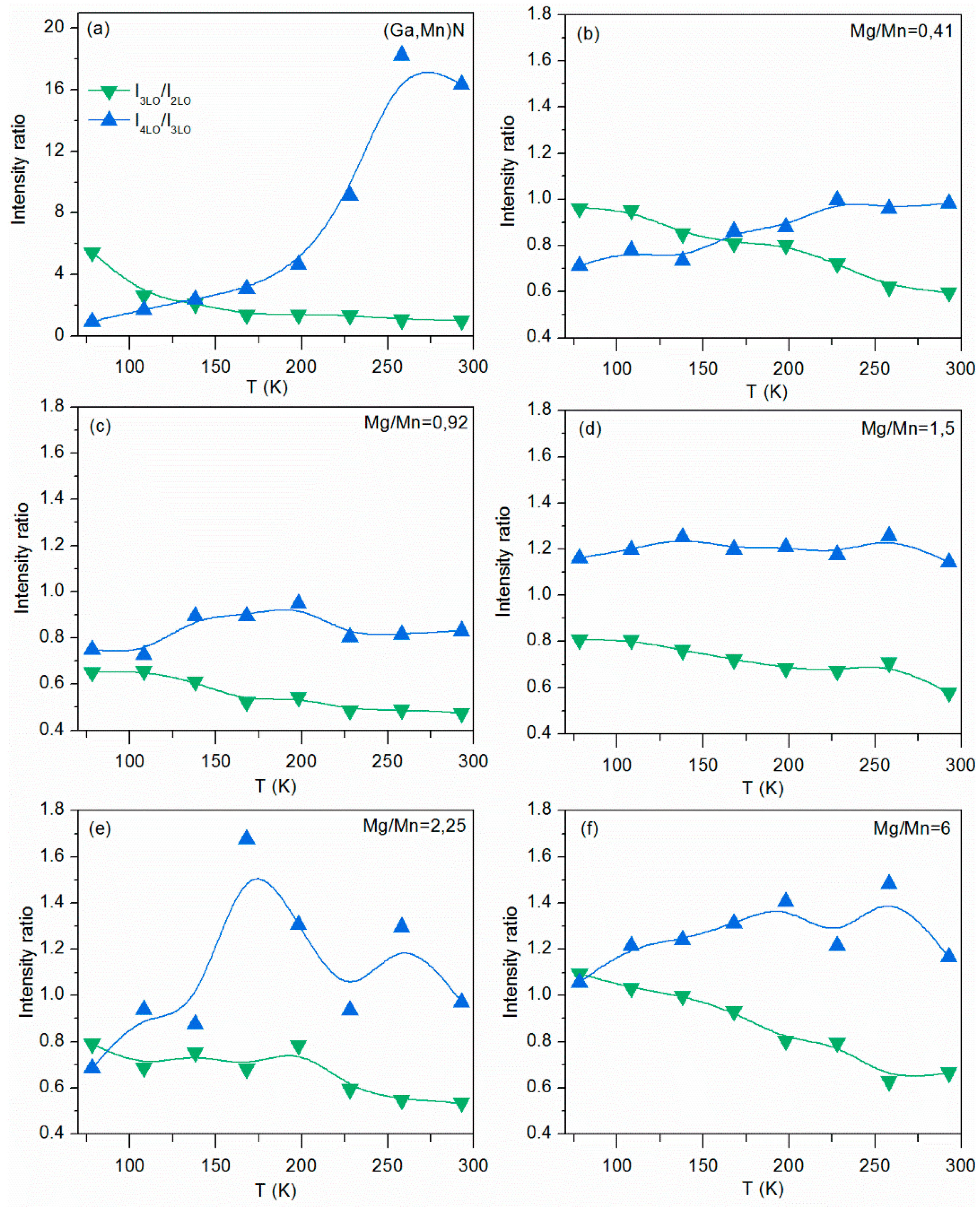
| # | Sample | xMn, % | xMg, % | Mg/Mn |
|---|---|---|---|---|
| 1 | GaN:Mn | 0.75 | - | - |
| 2 | GaN:Mg | - | 0.25 | - |
| 3 | GaN:(Mn,Mg) | 0.54 | 0.16 | 0.41 |
| 4 | GaN:(Mn,Mg) | 0.49 | 0.49 | 0.92 |
| 5 | GaN:(Mn,Mg) | 0.22 | 0.36 | 1.5 |
| 6 | GaN:(Mn,Mg) | 0.09 | 0.20 | 2.25 |
| 7 | GaN:(Mn,Mg) | 0.09 | 0.60 | 6.6 |
© 2019 by the authors. Licensee MDPI, Basel, Switzerland. This article is an open access article distributed under the terms and conditions of the Creative Commons Attribution (CC BY) license (http://creativecommons.org/licenses/by/4.0/).
Share and Cite
Nikolenko, A.; Strelchuk, V.; Tsykaniuk, B.; Kysylychyn, D.; Capuzzo, G.; Bonanni, A. Resonance Raman Spectroscopy of Mn-Mgk Cation Complexes in GaN. Crystals 2019, 9, 235. https://doi.org/10.3390/cryst9050235
Nikolenko A, Strelchuk V, Tsykaniuk B, Kysylychyn D, Capuzzo G, Bonanni A. Resonance Raman Spectroscopy of Mn-Mgk Cation Complexes in GaN. Crystals. 2019; 9(5):235. https://doi.org/10.3390/cryst9050235
Chicago/Turabian StyleNikolenko, Andrii, Viktor Strelchuk, Bogdan Tsykaniuk, Dmytro Kysylychyn, Giulia Capuzzo, and Alberta Bonanni. 2019. "Resonance Raman Spectroscopy of Mn-Mgk Cation Complexes in GaN" Crystals 9, no. 5: 235. https://doi.org/10.3390/cryst9050235
APA StyleNikolenko, A., Strelchuk, V., Tsykaniuk, B., Kysylychyn, D., Capuzzo, G., & Bonanni, A. (2019). Resonance Raman Spectroscopy of Mn-Mgk Cation Complexes in GaN. Crystals, 9(5), 235. https://doi.org/10.3390/cryst9050235





